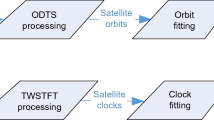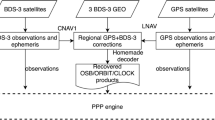Abstract
The BDS-3 preliminary system was declared functional on December 27, 2018. It enables positioning service on a global scale. This study conducts a comprehensive investigation of the BDS-3 global service from the perspective of positioning, including satellite ephemeris, benefits of the new BDS-3 satellites, and the new signal effect on three positioning modes: single-point positioning (SPP), precise-point positioning (PPP) and real-time kinematic (RTK). First, the broadcast and precise ephemeris availabilities of 18 BDS-3 Medium Earth orbit (MEO) satellites from January to June 2019 are investigated. Due to the shorter operational timespans of BDS-3 satellites, their broadcast and precise ephemeris files retrieved from Multi-GNSS Experiment (MGEX) have 1.2–19.4% and 10.9–13.77% discontinuities, respectively, while the discontinuities of BDS-2 satellite broadcast and precise ephemeris are only 0.1 and 2.1%. Second, the BDS-3 satellite orbit accuracies and clock precisions are significantly improved, i.e., below 0.5 m and 1.82 ns compared to 2 m and 2.91 ns for BDS-2 because of the inter-satellite links of BDS-3 satellites. Third, an average of 4.4–5.7 BDS satellites can be observed at stations located in North/South America, and 8.9 for the European station FFMJ located in Germany after the BDS-3 global system announcement. As a result, continuous positioning is feasible in these regions. As to four Asia–Pacific stations, their SPP accuracies are improved by 12.1–60.2% compared to those of the BDS-2-only solution. Meanwhile, the PPP and RTK convergence times of Asia–Pacific stations are also shortened. Last but not least, the new B1C signal does not bring convincing improvement to PPP and RTK positioning accuracies in this study, due to the limited number of available B1C new signals at this time.














Similar content being viewed by others
Data availability
BDS broadcast ephemerides were retrieved from: ftp://cddis.gsfc.nasa.gov/pub/gps/data/campaign/mgex/daily/rinex3/. BDS precise ephemeris were retrieved from: ftp://igs.gnsswhu.cn/pub/gnss/products/mgex/. BDS raw observations from MGEX stations were retrieved from: ftp://cddis.gsfc.nasa.gov/pub/gnss/data/daily/. BDS raw observations from the local BDS control network were not publicly available. Please contact the corresponding author by email: jbshi@sgg.whu.edu.cn.
References
Ananda MP, Bemstein H, Cunlllgham KE, Feess WA, Stroud EG (2002) Global positioning system (GPS) autonomous navigation. In: IEEE symposium on position location and navigation. Las Vegas, NV, USA, pp 497–508. https://doi.org/10.1109/PLANS.1990.66220
Chen D, Ye S, Xu C, Jiang W, Jiang P, Chen H (2019) Undifferenced zenith tropospheric modeling and its application in fast ambiguity recovery for long-range network RTK reference stations. GPS Solut 23:26. https://doi.org/10.1007/s10291-018-0815-x
CSNO (2017a) BeiDou navigation satellite system signal in space interface control document open service signal B2a (Version 1.0). https://www.beidou.gov.cn/xt/gfxz/201712/P020171226742357364174.pdf. Accessed 24 Oct 2019
CSNO (2017b) BeiDou navigation satellite system signal in space interface control document open service signal B1C (Version 1.0). https://www.beidou.gov.cn/xt/gfxz/201712/P020171226741342013031.pdf. Accessed 24 Oct 2019
CSNO (2018) BeiDou navigation satellite system signal in space interface control document open service signal B3I (Version 1.0). https://www.beidou.gov.cn/xt/gfxz/201802/P020180209623601401189.pdf. Accessed 24 Oct 2019
CSNO (2019a) BeiDou navigation satellite system signal in space interface control document open service signal B1I (Version 3.0). https://www.beidou.gov.cn/xt/gfxz/201902/P020190227593621142475.pdf. Accessed 24 Oct 2019
CSNO (2019b) BeiDou navigation satellite system signal in space interface control document open service signal B2b (Beta Version). https://www.beidou.gov.cn/xt/gfxz/201912/P020191227325641753862.pdf. Accessed 24 Oct 2019
Guo J, Xu X, Zhao Q (2016) Precise orbit determination for quad-constellation satellites at Wuhan university: strategy, result validation, and comparison. J Geodesy 90(2):143–159. https://doi.org/10.1007/s00190-015-0862-9
Hou P, Zhang B, Yuan Y, Zhang X, Zha J (2019) Stochastic modeling of BDS2/3 observations with application to RTD/RTK positioning. Meas Sci Technol 30:095002. https://doi.org/10.1088/1361-6501/ab1fad
Li X, Xie W, Huang J, Ma T, Zhang X (2019) Estimation and analysis of differential code biases for BDS3/BDS2 using iGMAS and MGEX observations. J Geodesy 93(3):419–435. https://doi.org/10.1007/s00190-018-1170-y
Lu M, Li W, Yao Z, Cui X (2019) Overview of BDS III new signals. Navigation 66(1):19–35. https://doi.org/10.1002/navi.296
Mi X, Zhang B, Yuan Y, Luo X (2019) Characteristics of GPS, BDS2, BDS3 and Galileo inter-system biases and their influence on RTK positioning. Meas Sci Technol 31(1):015009. https://doi.org/10.1088/1361-6501/ab4209
Ouyang C, Shi J, Shen Y, Li L (2019) Six-year BDS-2 broadcast navigation message analysis from 2013 to 2018: availability, anomaly, and SIS UREs assessment. Sensors 19(12):2767. https://doi.org/10.3390/s19122767
Shi J, Gao Y (2014) A comparison of three PPP integer ambiguity resolution methods. GPS Solut 18(4):519–528. https://doi.org/10.1007/s10291-013-0348-2
Shi J, Wang G, Han X, Guo J (2017) Impacts of satellite orbit and clock on real-time GPS point and relative positioning. Sensors 17(6):1363. https://doi.org/10.3390/s17061363
Wang C, Zhao Q, Guo J, Liu J, Chen G (2019) The contribution of inter-satellite links to BDS-3 orbit determination: model refinement and comparisons. Navigation 66(1):71–82. https://doi.org/10.1002/navi.295
Xie X, Geng T, Zhao Q, Cai H, Zhang F, Wang X, Meng Y (2019) Precise orbit determination for BDS-3 satellites using satellite-ground and inter-satellite link observations. GPS Solut 23:40. https://doi.org/10.1007/s10291-019-0823-5
Xu X, Wang X, Liu J, Zhao Q (2019) Characteristics of BD3 global service satellites: POD, open service signal and atomic clock performance. Remote Sens 11(13):1559. https://doi.org/10.3390/rs11131559
Yang D, Yang J, Li G, Zhou Y, Tang C (2017) Globalization highlight: orbit determination using BeiDou inter-satellite ranging measurements. GPS Solut 21(3):1395–1404. https://doi.org/10.1007/s10291-017-0626-5
Yang D, Yang J, Xu P (2017) Timeslot scheduling of inter-satellite links based on a system of a narrow beam with time division. GPS Solut 21(3):999–1011. https://doi.org/10.1007/s10291-016-0587-0
Yang Y, Gao W, Guo S, Mao Y, Yang Y (2019) Introduction to BeiDou-3 navigation satellite system. Navigation 66(1):7–18. https://doi.org/10.1002/navi.291
Yang Y, Yang Y, Hu X, Chen J, Guo R, Tang C, Zhou S, Zhao L, Xu J (2020) Inter-satellite link enhanced orbit determination for BeiDou-3. J Navig 73(1):115–130. https://doi.org/10.1017/S0373463319000523
Zhang M, Liu H, Bai Z, Qian C, Fan C, Zhou P, Shu B (2017) Fast ambiguity resolution for long-range reference station networks with ionospheric model constraint method. GPS Solut 21:617–626. https://doi.org/10.1007/s10291-016-0551-z
Zhang Y, Kubo N, Chen J, Wang J, Wang H (2019) Initial positioning assessment of BDS new satellites and new signals. Remote Sens 11(11):1320. https://doi.org/10.3390/rs11111320
Zhang Z, Li B, Nie L, Wei C, Jia S, Jiang S (2019) Initial assessment of BeiDou-3 global navigation satellite system: signal quality, RTK and PPP. GPS Solut 23:111. https://doi.org/10.1007/s10291-019-0905-4
Acknowledgements
This work has been supported by the National Natural Science Foundation of China (Grant No. 41504027) and CCCC Second Highway Consultants Co., Ltd (Grant No. KJFZ-2019-035).
Author information
Authors and Affiliations
Corresponding author
Additional information
Publisher's Note
Springer Nature remains neutral with regard to jurisdictional claims in published maps and institutional affiliations.
Rights and permissions
About this article
Cite this article
Shi, J., Ouyang, C., Huang, Y. et al. Assessment of BDS-3 global positioning service: ephemeris, SPP, PPP, RTK, and new signal. GPS Solut 24, 81 (2020). https://doi.org/10.1007/s10291-020-00995-y
Received:
Accepted:
Published:
DOI: https://doi.org/10.1007/s10291-020-00995-y




